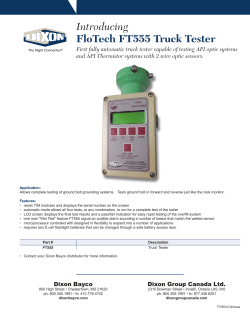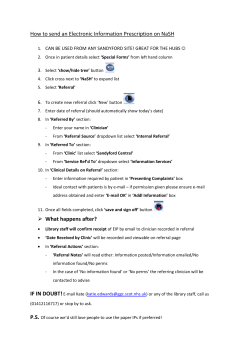
2015 Edition §170.315(b)(1) Transitions of Care
Please consult the Notice of Proposed Rulemaking (NPRM) entitled: 2015 Edition Health Information Technology (Health IT) Certification Criteria, 2015 Edition Base Electronic Health Record (EHR) Definition, and ONC Health IT Certification Program Modifications for a detailed description of the proposed certification criterion with which these testing steps are associated. 1. Required Tests Note: The order in which the test steps are listed reflects the sequence of the certification criterion and does not necessarily prescribe the order in which the test should take place. Note that Section 1.1 Item 3 is optional, depending on which edge protocol the Health IT Module chooses for certification. 1.1 Send and Receive Transitions of Care Documents via Edge Protocol Evaluate the Health IT Module’s ability to send and receive transitions of care/referral summaries through a method that conforms to the Implementation Guide for Direct Edge Protocols, Version 1.1, June 25, 2014 and optionally, receive and make available the contents of an XDM packaged formatted in accordance with IHE IT Infrastructure Technical Framework Volume 2b. Item # 1 Technical Outcome Test Lab Verification Test Approach A summary of care is transmitted to a third party via one of the following required edge protocols specified in the standard at §170.202(d): • IHE XDR or • SMTP. The tester verifies that the Health IT Module can transmit (send) the health information to a third party using one of the edge protocols specified in the standard at §170.202(d). Edge Testing Tool and visual inspection. Optionally, Health IT Modules may also be certified to one of the following optional edge protocols specified in the standard at §170.202(d): • IMAP4 or • POP3. 1 Item # 2 3 Technical Outcome Test Lab Verification Test Approach A transitions of care/referral summary is received via one of the edge protocols specified in the standard at §170.202(d) from a third party that has implemented the DIRECT: Applicability Statement for Secure Health Transport, Version 1.1, July 10, 2012. The tester verifies that the Health IT Module receives the health information through a method that conforms to one of the edge protocols specified in the standard at §170.202(d) from a third party that has implemented the standard specified at §170.202(a). Edge Testing Tool and visual inspection. Transitions of care summaries received from a third party that is using XDM packaging (that has been formatted in accordance with the standard specified at §170.205(p)(1)) can be viewed and incorporated by a user. The tester verifies that the Health IT Module utilizing the SMTP edge protocol can receive health information from a third party that has been packaged in accordance with the standard specified at §170.205(p)(1)) and make the contents available to a user. Edge Testing Tool and visual inspection. 1.2 Validate and Display Transitions of Care Documents Evaluate the Health IT Module’s ability to parse, detect errors, identify as valid and invalid, correctly interpret sections, record errors, and display in human readable format transitions of care/referral summaries received and formatted in accordance with both the HL7 Implementation Guide for CDA® Release 1.1: Consolidated CDA Templates for Clinical Notes (US Realm), Draft Standard for Trial Use, Release 1.1 (C-CDA (Draft Standard for Trial Use, Release 1.1)) and C-CDA Release 2.0 documents in accordance with the HL7 Implementation Guide for CDA® Release 2: Consolidated CDA Templates for Clinical Notes (US Realm), Draft Standard for Trial Use, Release 2.0 (C-CDA (Draft Standard for Trial Use, Release 2.0)). 2 Item # 1 Technical Outcome Test Lab Verifications Test Approach When a C-CDA formatted in accordance with the standards specified at §170.205(a)(3) or §170.205(a)(4) is received, it is handled in the following ways: • CCD, Consultation Note, History and Physical, Progress Note, Care Plan, Transfer Summary, Referral Note, and Discharge Summary document templates are parsed; • Errors in the document templates, section templates, and entry templates, including the use of vocabulary codes that are not specified in either implementation guide or that don’t exist in the value set, are detected, recorded, and users are notified of the errors so they can review them; • Valid document templates are processed, meaning that the data elements included in the section and entry templates are handled; and • Any empty sections and null combinations are correctly interpreted. The tester verifies that the Health IT Module can parse the document type correctly, according to one of the following document templates: Test data (multiple C-CDA documents with valid and invalid data) and visual inspection. • • • • • • • • CCD Consultation Note History and Physical Progress Note Care Plan Transfer Summary Referral Note Discharge Summary The tester verifies that the Health IT Module correctly identifies invalid C-CDA documents. This includes: • Document templates • Required sections • Required entries • Vocabulary standards and codes not specified in § 170.205(a)(3) and § 170.205(a)(4). The tester verifies that the Health IT Module correctly identifies valid C-CDA documents and processes the required data elements for required sections and entries, as specified in §170.205(a)(3) and §170.205(a)(4). The tester verifies the ability of the Health IT Module to track errors in received CCDAs and provide users with a mechanism to review them. 2 A user can view and read a transitions of care/referral summary received from a third party within their Health IT Module. The tester verifies that the displayed CCDA transitions of care /referral documents are accurate and complete, for documents received that are formatted in accordance with the standards specified in § 170.205(a)(3) and § 170.205(a)(4). Test data and visual inspection. 3 Item # 3 Technical Outcome Test Lab Verifications Test Approach A user can view an individual section of a transitions of care/referral summary and its header information received from a third party within their Health IT Module. The tester verifies the ability of the Health IT Module to display the document header information and each of the individual document sections (individually or together), for documents received that are formatted in accordance with appropriate standards as specified in §170.205(a)(3) and §170.205(a)(4). Test data and visual inspection. 1.3 Create Transitions of Care Documents Evaluate the Health IT Module’s ability to electronically create transition of care/referral summaries, care plan documents, referral notes or transfer summaries, which include the minimum CCDS includes the following data where applicable. 4 Item # 1 Technical Outcome Test Lab Verification Test Approach A user creates a transition of care/referral summary for a specific patient that is formatted according to the standards adopted in §170.205(a)(3) and §170.205(a)(4) and includes the following data, when such data is available in the patient record: • Common Clinical Data Set; • Encounter diagnoses in the standard specified at §170.207(i) or at a minimum the version of the standard specified at §170.205(a)(4); • Cognitive status; • Functional Status; • For ambulatory settings only: reason for referral, referring or transitioning provider’s name, and office contact information; • For inpatient settings only: discharge instructions; and • The following patient demographics: o First name o Last or family name according to the CAQH Phase II Core 258: Eligibility and Benefits 270/271 Normalizing Patient Last Name Rule version 2.1.0; o Maiden name; o Middle name (including middle initial); o Suffix the CAQH Phase II Core 258: Eligibility and Benefits 270/271 Normalizing Patient Last Name Rule version 2.1.0 (includes JR, SR, I,II, III, IV, V, RN, MD, PHD, and ESQ), and use a null value if no suffix exists; o Date of birth, including year, month, and day and if present hour, minute, and second (if hour, minute, and second are included either time zone offset is included or place of birth) and use a null value if date of birth is unknown; o Current address; o Historical address; o All phone numbers present in the ITU format specified in ITU-T E.123 and ITU-T E.164; and o Sex in the standard adopted at §170.207(n)(1). The tester verifies that the Health IT Module can create a transitions of care/referral summary document formatted according to the standards specified in §170.205(a)(3) and §170.205(a)(4), and including at a minimum CCDS and data requirements specified in the technical outcome. Test data, visual inspection, and the C-CDA validator within the Edge Testing Tool. The tester should utilize the C-CDA validator tool within the Edge Testing Tool to test C-CDA documents’ conformance to both §170.205(a)(3) and §170.205(a)(4). The tester should further utilize visual inspection to: • • Verify that coded values are within the specified value set for the standard at §170.205(a)(3) and §170.205(a)(4) and are accurate Compare values within the Health IT Module and the created C-CDA to verify that the values are accurate and contained in the correct C-CDA section. 5 2. Document History Version Number Description of Change Date 1.0 Released for Public Comment March 31, 2015 3. Dependencies For the related and required criteria, please refer to the Master Table of Related and Required Criteria. 6
© Copyright 2025











